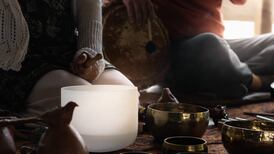Known locally as Crazy Jim, he had a habit of crawling on all fours, saddled and bridled like a donkey, around the main square of his native Todi, a hilltop town in Umbria. Yet he was one of the finest Italian poets of the Middle Ages and is considered to be the most likely author of the great Christian hymn, Stabat Mater Dolorosa. Other contenders for the authorship include at least three popes and three saints.
New light on the origin of the work is promised in a book by the distinguished Irish journalist, Desmond Fisher – finished just a few weeks before his death at the age of 95 in Dublin at the end of last year. Desmond, a Derry man, whose journalistic posts included editor of the Catholic Herald, London editor of the Irish Press and deputy head of news at RTÉ, spent the many years of his retirement researching the subject. His book, Stabat Mater, The Mystery Hymn, was published by Gracewing this month.
There are many roads to be following when exploring this haunting hymn to the Virgin Mary. Over the centuries it has been set to music by various composers, including Pergolesi, Haydn, Dvorak, Rossini and Vivaldi. (There was a memorable performance of Pergolesi’s arrangement in the old slate quarry on Valentia Island in 2004, directed by the Cork artist Dorothy Cross, and performed by the Opera Theatre Company from Dublin.) It was banned by the Council of Trent in 1545 but restored to the canon nearly three centuries later by Pope Benedict XIII to mark the Feast of Our Lady of Sorrows on September 15th. But interesting as the history of the hymn itself is it is less fascinating than that of its putative author, Jacopone Benedetti, Crazy Jim himself.
He was born into an aristocratic family in Todi around 1230, a time of war, plague and turbulence. He was sent to Bologna to study law and returned to Todi to pursue his career as an advocate, some say unscrupulously. After years of dissolute philandering at the age of 37 he married Vanna, the daughter of a local count. He did little to moderate his way of life but Vanna remained faithful. Then tragedy struck. There was a feast day in Todi and the local gentry assembled on a raised platform to watch the parade. The platform collapsed and Vanna was crushed to death. Jacopone tried to revive his young wife and he discovered that under her fine robes she was wearing a shift of coarse, hairy cloth. Shocked by her death and stunned by the revelation that she had been secretly doing penance for his misdeeds, Jacopone changed his lifestyle.
He gave up his comfortable career as a lawyer and took to to the streets and roadways of Umbria as a mendicant wanderer dressed in shabby robes.
After a decade on the roads he became a lay brother in the Franciscan Order in his native town but continued in his eccentric behaviour.
Invited to a wedding in his brother’s house he turned up naked, tarred and feathered from head to toe. Jacopone had a poem for it: “A wise and courteous choice he’d make/Who’d be a fool for the dear Lord’s sake.”
Within the Franciscans there was a minority group who wished to follow a more austere and frugal way of life. They were dubbed the Spirituals and not unsurprisingly Jacopone, always attracted by extremes, joined their company. They petitioned the new pope, Celestine V, for permission to establish their own order.
Celestine favoured their cause but under the strain of having to deal with warring Christian states and church intrigues and scandals he resigned in 1294 after only five months in office. He was succeeded by Boniface VIII who promptly locked up Celestine and ordered the recalcitrant friars to return to the jurisdiction of their regular superiors. There was a history of enmity between Boniface and Jacopone, dating from the time when Boniface got a plum ecclesiastical job in Todi in 1260 from the bishop of the town who happened to be his uncle Peter.
The poet’s support for the Spirituals was condemned by Boniface and he imprisoned his old adversary. While in prison he wrote some of his greatest poems. In the jubilee year of 1300 Boniface sanctioned the release of many prisoners but left Jacopone in the dungeon. It was not until Boniface died three years later that he regained his liberty.
Jacopone was now over 70, broken in body and spirit. After more wanderings he found refuge in the Convent of the Poor Clares near his native Todi. There he died on Christmas Day 1306 as midnight Mass was being celebrated in the chapel. He is buried in the Franciscan church, Tempio San Fortunato, in Todi. The inscription on his tomb says “.... having gone mad with love of Christ, by a new artifice deceived the world and took Heaven by storm”.
There are many translations of Sabat Mater. The latest is by Desmond Fisher. I hope Crazy Jim likes it.










